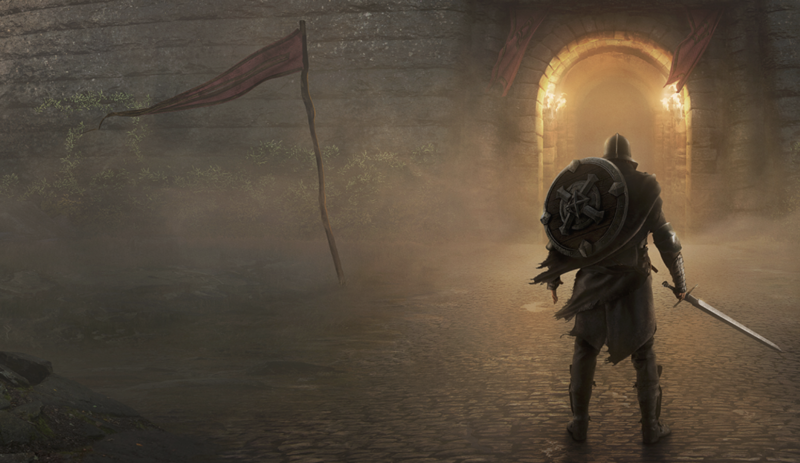
LOS ANGELES—A true The Elder Scrolls game on mobile? Not exactly. Recently-announced The Elder Scrolls Blades from Bethesda Game Studios is not a massive, free-roaming, systems-based super RPG. Instead, it's a casual dungeon crawler with a gorgeous presentation—and more bells and whistles than your typical mobile RPG.
I'm a passionate fan of the franchise, and I played the new mobile game for about a half an hour at Bethesda's E3 booth this week. In a similar way to spinoffs The Elder Scrolls Online and The Elder Scrolls Legends, I recognized the franchise's DNA but I also recognized that the growing game studio is trying something different here.That's not necessarily a bad thing. The streamlined game has top-notch visuals, the combat draws influences from the right places, and it feels entirely native to the device on which it runs. The game I played intrigued me, but I didn't get a sense of what might keep someone coming back for days or weeks after the initial download. Judging from the modes described in the initial announcement, that could be because the most interesting mode—the one in which you play through a story to build a town with non-player characters (NPCs) in it—wasn't on display at the show.
Instead, I played a lot of combat.
Oldschool dungeon delving on a newschool platform
When I sat down on a couch with a demo build of the game running on an iPhone X, I was presented with two modes: a forest experience and a castle keep experience. I started with the dungeon, hoping to get a sense for how real-time, first-person RPG combat would work on mobile.
-
This looks just like the forested ruin I battled through in the game.Bethesda
-
Draugr are back, and they look like they were plucked right out of Skyrim's asset library.Bethesda
-
I didn't get to play the town mode, which sounds like the most interesting one. But here's a screenshot Bethesda provided.Bethesda
-
I also didn't play the Arena mode, which sounds like it's player vs. player-oriented.Bethesda
The graphics looked excellent on the iPhone X's OLED screen in both portrait and landscape mode—it looked almost like actual assets from Skyrim were dropped into this game, and both the resolution and lighting were top notch. However, the environments lacked the interactivity the series is known for. The fidelity is great, but there aren't any interactable knick-knacks lying around, and the environmental storytelling that Bethesda is so good at is nowhere to be found.
The dungeon I explored was a linear one. I moved from room to room using two movement schemes. You can tap on the ground to automatically walk to that location, or you can hold your finger on the left side of the screen to move with a virtual joystick. In either case, you look around by drawing your finger from side to side or up and down on the right side of the screen. The movement controls are almost identical to the excellent iOS port of The Witness, if you've tried that one out before.
I could tap on doors to open them, or tap on certain jars to break them open for currency loot (I never received any equipment drops). When I encountered an enemy, it walked towards me, and the camera became largely stationary. At that point, I could hold down my finger on the screen to take a swipe at the enemy with my weapon. Where I pressed changed where my swipe went, and getting around enemy defenses was part of the challenge.
I could also hold my finger down on a shield icon to block, and there were two spell buttons—one for an electricity-based magic attack, and another for "blizzard armor," which appeared to create a swirl of ice around my character.
Combat played out similarly to that in the Infinity Blade series. With a full-screen view of the enemy, you need to react quickly to block attacks while striking in vulnerable spots with good timing. Rats crawl into the background outside the range of your weapons, and you have to time your attacks to hit them when they dash in for a bite.
I played an outdoor forest area, too. It was also essentially a linear dungeon, but with a different aesthetic.
The most intriguing part is yet to come
Few people play Elder Scrolls games for their excellent combat, if we're being honest. The appeal of those games is in Bethesda's finesse at environmental storytelling, an addictive and relaxing gameplay loop that lets you tailor your activities to your mood at any given moment. Fans of the series crave the immersion and surprise that emerge from systems-based towns and NPCs.
When creative director Todd Howard announced Blades at Bethesda's E3 press conference, he talked about a mode called Town in which the player would interact with NPCs, do story-based quests, and build out a small town into a thriving fantasy metropolis, all in first-person perspective. He even said that's the mode that's most similar to the Elder Scrolls experience fans love.
But since that mode wasn't included in Bethesda's playable E3 demo, I find it difficult to assess this game. The presentation is fantastic and the combat shows potential. But the verdict's out until we see that Town mode, which ought to be the glue to hold the experience together and keep it compelling for more than a few minutes.
Given that the same studio produced Fallout Shelter—one of the best mobile games I've ever played—my expectations remain high. The game will be free to play when it launches on iOS and Android later this year, so we'll find out if it lives up to them soon enough.
https://arstechnica.com/gaming/2018/06/the-elder-scrolls-blades-at-e3-its-not-skyrim-but-does-it-need-to-be/Bagikan Berita Ini














0 Response to "The Elder Scrolls Blades at E3: It's not Skyrim, but does it need to be?"
Post a Comment